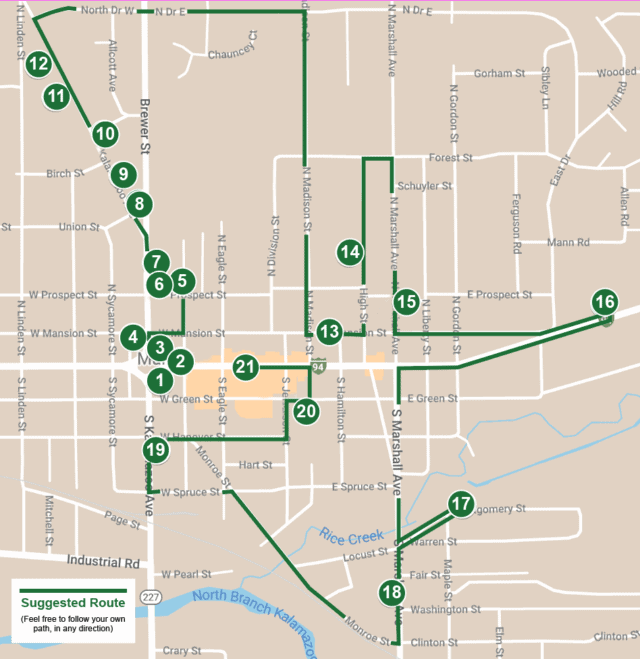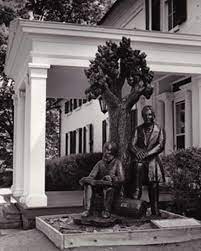
1 Tuliptree 323 W. Michigan Avenue, in front of the public bathrooms at City Hall. The tuliptree is a fast-growing tree with bright green leaves that are shaped like tulips and turn golden yellow in fall. We have noticed a lot of lazy bees all over the tree in the fall.
2 Sycamore northwest corner of Michigan Ave and Grand Street. This species is the largest growing hardwood in the United States, reaching over 100 feet in height and up to 8 feet in trunk diameter. The unusual mottled bark with patches of green and white make this an interesting tree throughout the winter. Specimens can be found throughout the entire town.
3 Northern Catalpa 107 N. Park St. by the drive-in entrance. Also known as the “cigar tree” because of the shape of its long see pods. The catalpa is an open branching tree with giant heart-shaped leaves and huge, showy white flowers in June. A short lived tree, usually not lasting more than 40-50 years.
4 Weeping Mulberry 107 N. Kalamazoo Avenue, The Honolulu House. This Mulberry was brought to Marshall from China with the hopes of supporting a silkworm industry. The industry failed because our winters are too cold for the worms, but the tree remains. The weeping form of Mulberry is unusual, it grows very fast and forms a dense mat of branches.
5 Copper Beech 311 W. Prospect Street. This spectacular specimen has a huge, thick trunk, smooth gray bark and dark red leaves that turn to a beautiful copper color in the fall. These deciduous trees grow slowly but develop into sturdy, low-maintenance shade trees. This tree is unusually large for this area, where extreme cold can damage tender shoots in the spring.
6 Education Oak, (removed) at the west side of 310 W. Prospect Street, the Brook’s house. Marshall played a significant role in the formation of the public school system in Michigan. Legend says that Isaac E. Crary and Reverend John D. Pierce sat under a large oak tree by the side of the Brook's House in 1834 and laid the foundation for the Michigan Public School System, which was included as a part of the 1835 Constitutional Convention. Learn more about the fate of this famous tree in #20 of this tree walk.
7 Jens Jenson Garden on North Kalamazoo behind 310 W. Prospect Street, the Brook’s house. The Brook’s House property contains one of the few remaining examples of private residential landscape work done by Jens Jensen, a gifted and controversial landscape architect who died in 1951. Jensen was a Danish landscape architect known for designing many parks in Chicago and using exclusively native species in a naturalistic manner that came to be known as the “Prairie style.” Jensen also designed landscapes for Frank Lloyd Wright and Henry Ford, among others.
8 White Pine 400 North Kalamazoo, evergreen trees in front of the house. Chosen as Michigan’s State Tree, these soft and graceful trees once covered much of upper Michigan and served as the primary source of lumber in the 1800s. Notice the characteristic horizontal branching and whitish-green needles. Virgin white pine can still be found at Interlochen and Hartwick Pines State Parks.
9 Cottonwood 418 North Kalamazoo. A fast-growing tree that sends down a barrage of cottony white seeds in May. As a member of the poplar family, the cottonwood has flattened leaf stems that allow the leaves to flutter in the wind.
10 Swamp White Oak 515 Hobart Street. Swamp white oak is a striking tree with attractive peeling bark, especially on young trees. The lustrous, lobed leaves are dark green on top and silvery-white underneath. Leaf color changes to an orange-gold to yellow in mid-autumn. An excellent shade tree for any landscape, this particular specimen is unique for its tall, narrow form and its coarse descending branches.
11 Norway Spruce 603 North Kalamazoo. A native of northern Europe, this evergreen has proven adaptable to the United States and has been planted extensively as a landscape tree in Michigan. Identified by short dark green needles that feel square when rolled between your fingers and graceful up-swinging branches. This pine has light brown cones that sit upright on the branch until fertilized. Once fertilized, they gradually turn downward
Norway spruce trees support a wide variety of wildlife. They are important as winter cover for deer and small game including grouse, rabbits and song birds. Norway spruce also makes a good roosting tree for hawks and owls.
12 Bur Oak 613 North Kalamazoo. Native to the Midwest, Bur Oaks are strong, long-lived trees excellent for timber products and landscape uses and are resistant to both insects and disease. Recognized for having large solid trunks with gray to brown furrowed bark and an open, coarse branching pattern. It has dark green leaves with rounded lobes that turn yellow-brown in fall. Marshall has a number of fine specimens, see if you can find more!
13 Wolf Tree, (removed) in the middle of Mansion Street in front of The Franke Center for the Arts. In Marshall’s early years a large oak tree stood in the middle of Mansion Street that had a platform lodged in its branches. This is where Lyman Fish “The Wolf Hunter” sat every night performing his duty as night sentry, shooting wolves that posed a threat to the villagers and their animals.
14 Ginkgo 327 High Street. (This property also has large Catalpa trees.) Called “undoubtedly one of the most distinct and beautiful of all deciduous trees,” the ginkgo certainly stands out. Its unique, fan-shaped leaves turn a stunning yellow color in the fall and are used in medicines around the world. It can tolerate many urban conditions including heat, air pollution, salt, and confined spaces.
These trees can live as long as 3,000 years and are also considered a living fossil. The earliest leaf fossils date from 270 million years ago.
15 Tuliptree 222 North Marshall. Spring tuliptree flowers provide nectar for ruby-throated hummingbirds and its seeds provide food for both birds and small mammals, like squirrels and rabbits, throughout the fall and winter. Blooms in May and June, producing tulip-shaped flowers high in its crown with greenish-yellow petals and a splash of orange at the base.
16 Camperdown Weeping Elms 845 East Michigan. These highly unusual specimens are very conspicuous on the north side of East Michigan Avenue. Their contoured, weeping branches are grafted onto straight trunks. Trees can grow up to 25 feet tall, but most are much wider than they are tall. Many insects choose these leaves as a favored meal.
17 Willow and White Pine Grove Ketchum Park Ketchum Park is an easily accessible natural woodland park found in the middle of the city. Take a shaded walk through the soft bedding of white pine needles and admire the willow trees with their long weeping branches beside the footbridge.
18 White Pine 612 South Marshall. This unique tree enhances the historic quality of the proposed Michigan governor’s residence since the eastern white pine is the largest conifer native to Eastern North America.
White pines have long, soft, velvety, blue-green needles that wave in the breeze, adding some extra dimension and texture to the landscape. The white pine is the only pine that has 5 needles in a cluster. White pines are typically 20 to 30 years old before they produce pine cones. There are a significant number of white pines in Marshall.
19 American Elm 309 South Kalamazoo. Once the king of shade trees that graced almost every American street until the 1950s, American elms have been devastated by Dutch elm disease. The specimen seen here is one of Marshall’s only remaining specimens. Trees that have withstood the disease can live for hundreds of years, have branches like spreading fountains, and green leaves that turn gold in fall.
20 The Education Oak, (current location) in the lobby of Marshall Middle School. See #6 for an introduction to The Education Oak. After working together on the plan for Michigan's public school system, Isaac Crary served as Michigan’s first congressman and Rev. Pierce became Michigan’s first Superintendent of Public Instruction. When efforts in 1980 were unsuccessful to save the famous dying oak tree, a chainsaw artist crafted a statue of Crary and Pierce from the tree. This statue is now housed in the foyer of the Marshall Middle School. You must follow all visitor protocols of the school to view the statue, please check in at the school office if you want to visit.

Image of Education Oak in its original location alongside Brooks House courtesy of the Marshall Historical Society.
21 Cleveland Select Pear Trees Downtown Business District. End your tour in downtown Marshall with a well-deserved break in our Social District. While there, admire the handsome pear trees that line the street. They create a more comfortable sense of scale in the central business area, visually soften the hard building surfaces and also reduce provide a dampening effect on street noise. Cleveland Pears display an intense white flower in early spring, glossy green leaves in the summer and purple leaves during the fall. This pear tree withstands ice and wind damage, has few pest problems, is tolerant of heavy clay soils and is fruitless. It reaches a maximum height of 30 feet and a width of 15 feet. Planted with funds raised by citizens in 2012, these trees convey a strong sense of community cooperation and pride.
While every effort has been made to ensure accuracy, if you find any errors please let us know by calling the Marshall Welcome Center at 269-781-5163 and asking for Kimber, or CLICK TO EMAIL.